Shaft Razor long test, with a look at the competition
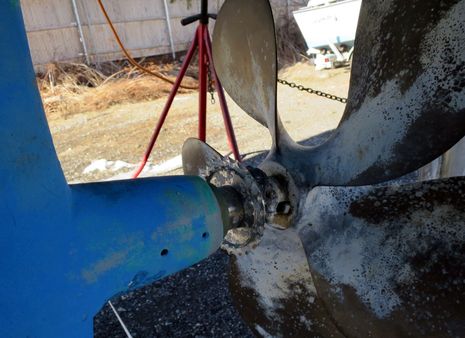 There are still patches of icy snow left from a memorable March in Maine, but I enjoyed a recent afternoon wandering around the boatyard checking out shaft cutters. Pictured above is the Shaft Razor that’s been protecting Gizmo from line wraps since the spring of 2010. Like my stainless rudder it picked up a lot of barnacles last fall, but that double set of super-sharp serrated teeth were still quite effective. The Shaft Razor is also a good value that has required zero maintenance, and while I saw some interesting competition around the yard, I wouldn’t trade it…
There are still patches of icy snow left from a memorable March in Maine, but I enjoyed a recent afternoon wandering around the boatyard checking out shaft cutters. Pictured above is the Shaft Razor that’s been protecting Gizmo from line wraps since the spring of 2010. Like my stainless rudder it picked up a lot of barnacles last fall, but that double set of super-sharp serrated teeth were still quite effective. The Shaft Razor is also a good value that has required zero maintenance, and while I saw some interesting competition around the yard, I wouldn’t trade it…
First, here’s a closer look at the Shaft Razor that better shows its simple one-piece design and diabolical teeth. The precise CNC machining is done in Rockland, Maine, by the Evolution Company (which also manufactures a nifty fuel-efficient, vibration-dampening shaft system). Installing the Razor did require the removal of Gizmo’s prop, but the worst case failure entails two set screws letting go, which is doubtful and would still leave me with a repairable Razor.
I don’t believe that any running gear protection system is 100% effective; eventually, some line or net will find a way to foul itself on your rudder or shaft nut or somewhere. But the Razor has worked very well over many miles now, often in waters so thick with lobster trap buoys that, “You could snowshoe across them”! I try hard to avoid them, and I know the tricks — like not to pass close to a pot warp that’s streaming downcurrent away from me. Sometimes, when the inevitable happens, I have to back down to bring the offending line to the cutter, but Gizmo has never gotten hung up and I’ve only had to go overboard to clear some annoying remains once. (For that purpose, I carry a wet suit, a mask, a fabulous Sailor’s Solutions Hooknife, and a pair of kevlar gloves to protect me from my Razor.)
So, I’m not surprised that the simple disc-style shaft cutter is quite popular, at least in Maine. I didn’t bring a clipboard, but at least two-thirds of about 50 mid-size power and sailboats stored outside around Wayfarer Marine have cutters of some kind, and about two-thirds of those are disc type. However, I don’t understand why I saw a lot more Shaft Sharks than Shaft Razors. The Shark does have the same aggressive serrated outer blade, and some sizes are available in easier-to-install split versions, but I really like how the forward facing blade on the Shaft Razor is also serrated.
I’ve heard that a severe line wrap between the prop and aft shaft bearing can damage that bearing, so I like the idea of sharp teeth eating away at that sort of wrap as it forms. Do we all agree that serrations cut line much better than the straight blade seen above on the front of the Shaft Shark? For the same reason, the single straight blade on the Prop Protector disc doesn’t seem as effective. Plus the 4 11/16″ Shaft Razor that fits Gizmo’s 2″ shaft cost $386 retail, while a similar Shaft Shark split disc discounts at $529. Am I missing something?
The other cutters I saw in the yard were all of the scissor/chopper style and most were the popular Spurs Marine brand. The particularly heavy duty choppers above are not Spurs — I can’t identify the brand — but the photo nicely illustrates the general idea, which looks quite effective but is also darn complicated to manufacture and install. The after blade ring simply spins with the shaft, just like a disc cutter, but the forward blade ring remains stationary, held in place by that big spring-dampened stopper, while the shaft spins within an internal bearing. You are looking at three serrated line guillotines!
There’s an interesting third design style called a “shavercutter” and represented by the Quickwater Marine quickKutter from Australia, but I’ve never seen one in the flesh. I’ll close with a “belt and suspenders” rig seen on the seasoned cruiser below. This boat is not only equipped with Spurs, but also has two custom stainless steel appendages designed to keep lines from getting near the prop in the first place. If you know of other protection schemes or have experience with the ones I’ve listed, please don’t be shy…


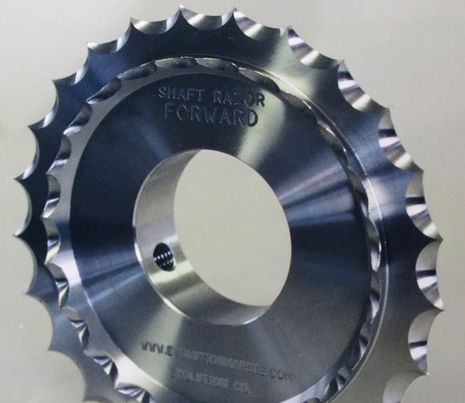
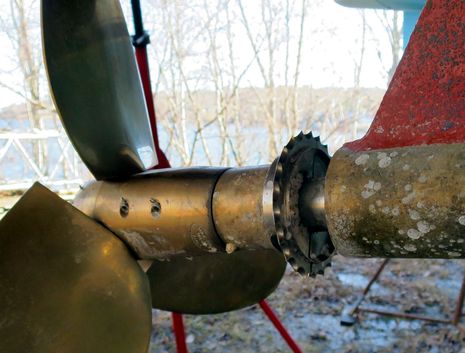
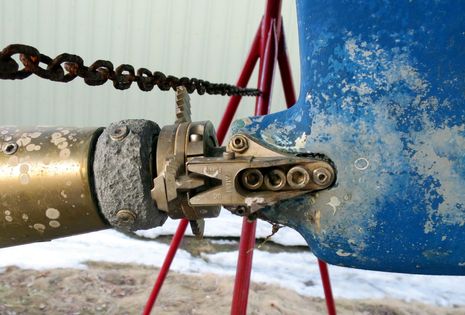
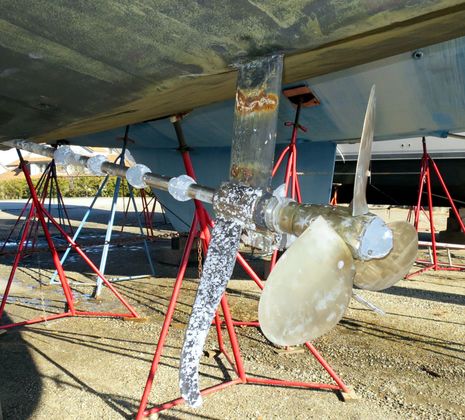


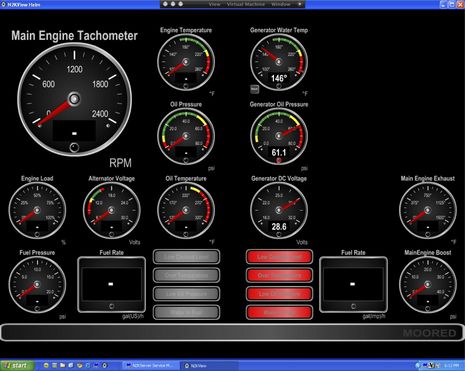
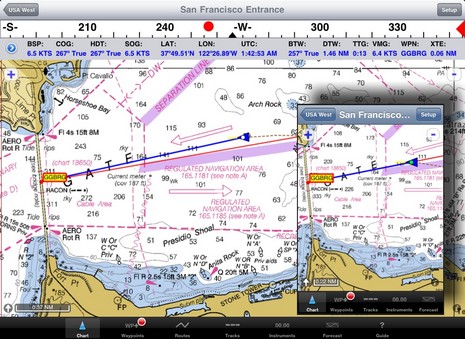








The cutter looking as Spurs is probably a Stripper usually installed by Hallberg Rassy:
http://www.ropestripper.com/strippers.php
Thanks, Laurent! No question that the next to last photo shows a Shaft Stripper made by Ambassador Marine in the UK. It’s interesting that they make both 2 and 3 blade models so you can match them to your prop and thus reduce drag.
Also, a builder like HR can make it easy to install what Ambassador calls a Striker Plate. Good parts photos here:
http://www.ropestripper.com/glossary.php
I live in Washington where we have shrimp and crab pot fisheries. The proliferation of floats during the various seasons is a serious hazard to navigation. It is frustrating, to say the least, maneuvering my boat through the maze of fishing floats. Our situation here is complicated by the having commercial, sports and native openings. The Coast Guard seems to not be concerned about the hazards from these floats. In self-defense I have a line cutter on my vessel. This protects my vessel but it creates abandoned pots the keep on fishing and costs the owners an expense that is not necessary.
I have a solution:
1)Allow multiple pots attached to a string between two retrieval floats. This would reduce the number of floats on the surface.
2)Do not allow floats in a channel. Fishermen could deploy pots in the channel, but the retrieval buoy would have to be outside the channel.
3)The creation of transit lanes within which no floats would be allowed. Again fishermen could deploy pots in the transit lanes but the retrieval buoys must be outside the lanes.
4)Buoys deployed during hours of darkness need to be lighted.
I believe my proposed modifications to the current regulations would make our waters safer to navigate, reduce gear loss, and not impact the harvesting of the seafood.
With GPS and modern cartography the no buoy zones would be easy to establish and comply with.
Patrick Harman
Oak Harbor, WA
Having been sailing and powering on the Maine coast for well over 50 years, I do have some experience with lobster pots! I’ve tried several different cutters over the years. They work most of the time, but I really hate the idea of cutting off a working person’s livelihood. For both sail and power I’ve finally arrived at the solution of not avoiding lobster gear but rather having it avoid you.
The last sailboat had a skeg protected rudder. I ran a stainless cable from the bottom of the keel to the bottom of the skeg. Never once did the line manage to get close enough to the propeller to be fouled.
In the case of the power boat, if – and this is a big if – you are willing to travel at displacement speeds, i.e. up to about 8.5 kts, then I cannot recommend highly enough opting for a cage. The cage will need to be custom designed and built stoutly so not cheap, but unbelievably effective. Our current boat has one and I read the NY Times as we go through beds of lobster gear. I never deviate one degree to avoid a line or toggle and never once in probably well over 50,000 encounters have seen anything other than the toggle popping up in our wake after we’ve passed. It works. It really works, but if you try to go over displacement speed forget it. There is so much drag from the cage that you’re just burning vast amounts of fuel to get maybe another 1/2 knot speed. Incidentally, this means you can travel at night or in extremely foggy weather without worrying about fouling the propeller. This alone makes it very attractive in the Down East waters.
I wonder if that boat in the last picture is over zinc’d. Sure looks like it.
I have the Shaft shark and haven’t had any lines wrap around my prop. Might not have hit them either. In Mexico you can usually avoid the fishing lines but at night it is a whole different animal.
UK sailing magazine Yachting Monthly (www.yachtingmonthly.com) did a test of rope cutters in their April 2009 edition titled “Cutting it, seven rope cutters tested”.
The products tested were:
Spurs http://www.spurscutters.co.uk
Ambassador Stripper http://www.ropestripper.com
SAK Equipment Gator http://www.sakequipment.com
Plastimo http://www.plastimo.com
R&D http://www.randdmarine.com
Prop Protector http://www.prop-protector.co.uk
TW Norris Shaft Knife http://www.tnorrismarine.co.uk
Spurs, Stripper and Gator got 4/5 stars, Plastimo, R&D, Prop Protector, Shaft Knife 3/5 stars.
My boat came with a serrated disc type in one piece, probably the Plastimo. I don’t believe in it and would like to replace it with Ambassador or Gator.
But I think it’s a mistake to buy any single device and think that you have solved the problem. You will also need diving gear, diving training, a compressor (there are now oil-less compressors with ceramic pistons available cheaply at building supply stores but you need a good inverter) or bottles and the hook knife Ben linked to also looks like a good idea.
IMO, the topic of fishing floats is certainly not a nuisance but a very real danger and it is very hard for me to remain objective.
So what if my livelihood depended on putting 1-ton concrete blocks in the middle of highway lanes, ideally placed behind curves? There probably is a law against it but what if there weren’t? Does that make this a fair thing to do?
On the Spain and Portugal Atlantic coasts, fishing floats are, in my opinion and that of other boaters, the greatest danger that you face. I have myself seen floats set out to 125meter (~400ft) depth and were told of 200m (~600ft) by experienced cruisers. To travel outside of this depth often means going out 15 to 25 miles into the ocean. In any case, this means you are in areas contaminated with floats for 3 to 5 hours on the way out and the same on the way in. So you can forget about “only travel in daylight”. An it is extremely hard to notice them even in daylight. My wife and me have really tried and still narrowly missed them by luck only on multiple occasions. Their placement doesn’t follow any kind of logic that I could see, as hard as I have tried.
Cruising friends with their propeller in an aperture badly fouled their prop with a float line and ruined their cutlass bearing, causing a 3-week forced break in their travels. They and others bypassed places they would have spent a week exploring only because it would have forced them to transit float areas at night.
20 miles off the coast you will find swell that will make diving from a 10-20 meter boat potentially life threatening.
In the English channel, when we fouled our prop with a maze of orange polypropylene netting that no rope cutter would have had any chance of cutting, we were able to get professional help dispatched from the Belgian port Nieuwpoort, 25nm away. I have strong doubts that the Spanish or Portugal marine salvage operations would be willing to provide the same service this far out.
In the book “Moby Duck” author Donovan Hohn describes in great detail how many thousands of tons of fishing netting is lost each year at sea.
A little bit of your average netting will entangle your prop to the point where you would not recognize it as a propeller anymore. There is no way at all that a rope cutter could deal with this.
Definitely one of the bad bits of cruising. And there is no way to buy yourself out of it. Because it is you having to go into the water in the middle of the night in water so cold as to make you hyperventilate even with a neoprene suit (which makes diving very hard without some kind of breathing system) and with a 6 foot swell that makes the stopped boat’s stern slam hard into the seas, sending spray flying out 20 feet. With your wife looking over the railing in fear and the child crying. Getting back on board in this situation will, by all counts, be like a full-on MOB recovery.
I have never seen a prop case on a sailboat but I will spend some time thinking about it.
Have used a Shaft Razor for 15 years on my Krogen 42. 40000 miles later never a problem snatching a crab or shrimp pot between Olympia, WA and Skagway, AK. However if we did pick up a line we never knew it had happened. I’m a fan.
Thanks, Henning, but I can’t find any evidence that the SAK Equipment Gator still exists. However, I did find a PDF of a 1999 Sailing Today cutter test that may be related to what you saw in Yachting Monthly:
http://www.ropestripper.com/documents/st-ropecutters.pdf
It looks like your Plastimo cutter is exactly the same design as the Shaft Sharks that are so popular here in Maine. As stated, I think the similar Shaft Razor design is slightly better, but I also strongly question Sailing Today’s 2 star rating.
I really appreciate Sailing Today’s testing efforts but I think it’s darn hard to actually simulate what happens in the water when lines and props come together, and I think they somehow missed on the Plastimo.
I’m especially surprised that the single blade, unserrated ProProtector did better than the Plastimo/Shaft Shark.
At any rate, Henning, I think you have a better cutter than you realize and a lot of very experienced — it can’t be helped — Mainers agree 😉
GIZMO has a Max-Prop?
Has anyone had any experience with the Seatorque “Boss” shaft system with QuicKutter rope cutter? I’m considering ordering this on my next boat.
On my cruising sailboat in Maine, Acorn (a Bermuda 40 with keel aperture prop location), I had a prop cage installed by an experienced fabricator of such things for lobstermen. We are still super-careful about avoiding pot markers while underway, but when the unexpected one, or a “sinker”, gets under us it is a great comfort to know the cage is there. Nobody can expect a cage to deflect poly-line 100% of the time but it is way more reliable than all the rest of the available solutions to this problem. Before the cage installation I’ve been overboard with a knife and THAT is no fun and quite dangerous under many conditions. Speed loss under power is about 0.18 knots less than the former 6.6 kt. cruise speed, so far as I can tell from the B&G instruments. So that’s less than a 3% loss while at cruising speed, which is an acceptable trade-off for me. I have noticed less than a few cages on sailboats during boatyard strolls, but nevertheless they work well, and it’s worth saying that lobstermen would not be wasting good money on cages without knowing their value.
I have never had any kind of cutter or a cage — in fact my lobster-catcher friends would probably like to lynch me if I installed a cutter. And I don’t want the drag of a cage just for the small ammount of time I spend in gear-infested waters.
But a displacement boat tends to push buoys aside, true both of my lobster-boat Nimbus and of Barbara. I do avoid running above buoys stretched out by the tide, but I have several times run through passages full of gear (Muscle-Ridge Channel, Davis Strait, to name two close to Ben), and have never had any trouble.
The times are changing. I took a stroll around a Rockland boatyard this week and most of the lobster boats and other fishing vessels I saw did not have cages. A few even had cutters.
I am very careful about avoiding lobster trap lines but there’s a growing sense along this coast that the fishermen also have some responsibility in this issue. Heck, you can catch a trap on your prop while swinging on a mooring in Camden’s outer harbor!
Curtis Rindlaub, author of the great Cruising Guide to the Maine Coast, has hosted some heated conversations on this topic: http://goo.gl/PXZ2iY
Well, lobster is probably my favorite seafood and I have fond memories of eating some with our fingers on a bench in front of the ‘Dock House’ in Sag Harbor, NY, with a bottle of wine picked up at the grocery but if some divine being offered me a trade “no more lobster for the rest of my life for the guarantee to never foul a fishing float with my propeller”, I would accept in an instant.
Howdy Ben:
Just saw your post on shaft cutters. Timely as I am in Seattle with Todd et al doing purchasing cycle for the FPB 78s (first three) and the PO is at hand is for line cutters.
Question for you re the cutter you are using… it appears to be held in place wth set screws. Are there dimples on the shaft for the set screws, and any problem with slippage?
The Shaft Shark has a clamp connection, which in theory should be better, but what looks like less efficient cutting surfaces, i.e. your Razor has the twin blades.
Finally, what, if any, is the impact on prop efficiency of this turbulence generator ahead of the propeller blade roots? Did you notice any difference in speed, fuel burn, noise/vibration?
We have been using the Spurs cutters for many years, and they do work well, but are maintenance hassle.
Regards-Steve
Hi Steve,
Evolution Marine does recommend “spotting” the shaft with a drill for the Shaft Razor set screws, and they claim that their solid design fails less often than split discs. The Shaft Shark does have two blades but the forward facing one isn’t serrated like the Shaft Razor’s.
I didn’t notice any performance change after installing the Razor in 2010, but then again I don’t generate a “Dashew” level of performance data 😉
The latest FPB 78 renderings are fantastic!
I only picked up ONE line, and it was a neutral floater, a 3″ Hawser that was stirred up from the bottom by a channel dredger. All the cutters in the world would not have helped.